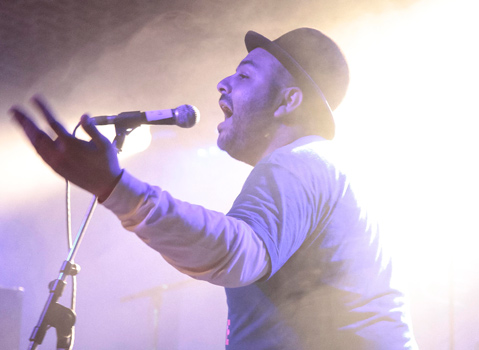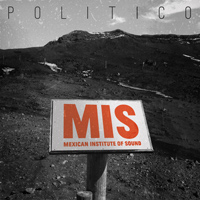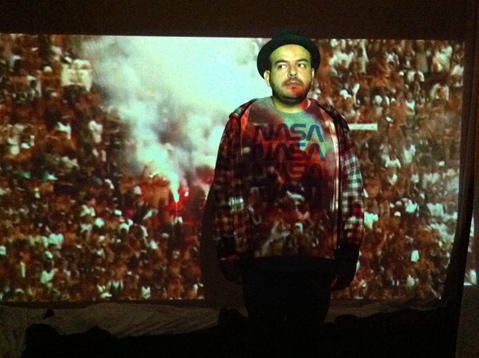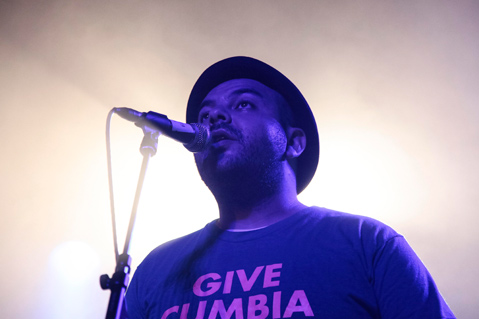Mexican Institute of Sound’s Globo-Cultural Fusion
DJ Camilo Lara Talks Day of the Dead and Morrissey Tribute Band

Mexican Institute of Sound is the creation of deejay/producer Camilo Lara, who got started making holiday “best of” mixes for his friends that included his own creations sampling traditional Mexican instrumentation, song structure, and mariachi guitars and horns. Those mixes evolved into entirely original tunes recorded and now performed with a live band and vocals onstage, providing compulsively danceable electronica that bubbles up, like hot sauce, from Mexico’s urban hotbed of globo-cultural fusion.

His other band, Mexrrissey (Mexico + Morrissey = Mexrrissey) has recorded tributes to Morrissey, and Politico is the Mexican Institute of Sound’s fourth album, composed of explosive club bangers that bridge worlds between Mexico City, Tokyo, Barcelona, and New York, mapping Lara’s eclectic musical and literary imagination with a whimsical sense of humor. I recently had an email interview with Lara in which I asked about his music and his relationship with Moz’s (Morrissey’s) music.
You are playing several Día de los Muertos shows this year. What do you think of how the holiday has taken off in the United States? Did you grow up celebrating it as a kid? Well, yes … it is very, very Mexican. There is no way you can miss that celebration. It’s funny because in the U.S., Día de Muertos is all about skulls and cadavers. In México, it is about the beloved who are gone — more of a small tribute to the people you miss and less like “Party Like It’s 1999.”
Given the success of your Morrissey tribute band, Mexrrissey, you’re an expert. Please explain the love affair between a white Brit who sings about Oscar Wilde and his loyal Mexican “Moz” disciples. Thank you! A few months ago, our biggest singing star Juan Gabriel, known as Juanga, passed away. Whenever people ask me this question — believe me, I get this once a day! — I keep telling them that Moz and Juanga are very similar. Both are very ironic, have a twisted sense of humor, both are melodramatic, both play with their sexuality. So I guess Mexicans just connect with that. Plus Morrissey became a sort of fashion icon with the Mexicans in the States, so the combo is irresistible! Moz is our favorite güero!

Iggy Pop has praised you and your tribute band on his BBC show. Why does placing Morrissey into the traditions of Mexican music offer such deep insight into Morrissey’s emotions and themes? I guess Iggy Pop (oh my god, Iggy Pop!) liked our music because it is not a tribute band. I sort of reimagine the songs as if Moz was from the same barrio as me. There is a cosmic connection with Moz music and Mexican music. I think that the way guitars are used can naturally translate into trumpet sounds. And, also, Morrissey is one of the best songwriters of our times. His songs are great pop songs — as good as Gershwin, Cole Porter, or José Alfredo Jiménez [a famous Mexican singer of rancheros]. Morrissey has created pop standards that deserve to be reimagined and absorbed into pop culture everywhere.
When was the first time you heard Morrissey, and who else did you listen to internationally before you began your music career? Who inspired you? Who made you think “this is what I want to do”? I heard The Smiths when I was a kid, and it became the soundtrack to my childhood. I was into New Wave — from XTC to Suburban Lawns. The Smiths were part of my DNA as a musician. It was outsiders’ music. It was designed for people like me — nerds and misfits. Because of The Smiths, I started discovering people who I liked, who I could share a vision of the world with. When later in my life I learned English, I discovered that his lyrics were actually pretty cool!
Even though your music is fusive, highly danceable, and experimental, you’ve gone deep into the cultural treasures of Mexico, such as sampling Mexican novelist Juan Rulfo’s voice to ’40s Mexican songs such as Bola de Nieve’s lullabies. Why are these resonant to your music now? Well, I have a very big list of influences. I don’t discriminate. John Cale is as important as Pérez Prado [King of the Mambo]. Andrés Landero [the Cumbia King] is as punk as Joe Strummer. There’s a lot of great outsiders art. There are a lot of elements that help create the Mexico I love. Without the French playwright Antonin Artaud, many Mexican artists wouldn’t have gotten into the absurd or avant garde theater. Juan Rulfo in a very subtle way invented the idea of dreamy Mexico. In many ways Morrissey defines the aesthetics of Mexican migrants.

Your music is international and folk and ethnic and electronic all at the same time. How do you explain your eclecticism, restlessness to cross borders, affection for high and low, and desire to meld genres and eras of music? I think the only real democratic place on Earth right now is the dance floor. On a dance floor, you can be poor or rich, ugly or pretty, black or white. If music is good, it unifies the crowd. So why not make music that unifies? It all fits on a global dance floor.
You have so many bands — Mexrrissey, Compass, Mexican Institute of Sound. What’s the relation between them? What makes you choose music that is particular to each? I think my mother ship is Mexican Institute of Sound. Compass was an attempt to get a bunch of people in the studio to collaborate with. Mexrrissey is doing music with people I like.
You’ve written a song called “Mexico” about a police raid on a Somali terrorist group in Mexico City, and you’ve said that “Mexico is the sum of C-4 explosives and hearts.” Can you explain what you mean by that? I wanted to do a song that explains a little bit the frustration all Mexicans have with insecurity, drug trafficking, corruption, and fear. While I was doing my latest album, Politico, they found a huge amount of C-4 explosives in the building next to my house. It was shocking.
Politico caused a stir with the Mexican media, so I might as well ask: What do you think about Donald Trump’s wall? If Trump wins, we will need to build the wall to keep Trump supporters away from humanity. I’m not surprised about it. If the high art in America is Kanye, Trump is the perfect president for these crazy times. Television is the drug of the nation.
The first song I ever heard by the Mexican Institute of Sound was “Cha Cha Cha No. 29.” It riveted me. What was the inspiration for that song? Also, how did you come up with the band name Mexican Institute of Sound, and will there be a “Cha Cha Cha No. 30?” Hope so! [Laughs.] I did many Cha Cha Chas. [Number] 28 was really horrible, so the only one worthwhile was 29. Next good one will be Cha Cha Cha 48!
Mexico is artistically and culturally having an explosive effect here in the States, from taco trucks to filmmakers, such as Iñárritu, Cuarón, and del Toro, and musical groups like yours and your contemporaries. What do you think about this explosion of creativity? Most of these people have been around for a long time; they deserve to succeed. There is a lot going on. It’s a very exciting time for Mexico City. I guess it is like when Margaret Thatcher was in power, London was a miserable place to live, but it was a beautiful place for creativity. Mexico is going through horrible times with horrible leaders, but there is a beautiful thing called humanity, and its culture is an artistic society. Art is everywhere!
So have you met Morrissey? How do you feel about opening for him? If you could perform one song with him, what would it be? I’m really, really excited. I have never met him. It’s a very special event for me. Hope I do have the pleasure to meet him at the Bowl. I’d definitely like to sing “Camilo in a Coma” [Camilo’s adaptation of The Smiths’ “Girlfriend in a Coma”]!



